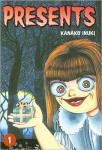I’m a big fan of Yuki Urushibara’s Mushishi (Del Rey), and I’m a big fan of episodic manga in general. I particularly like Urushibara’s thoughtful, expansive take on her subject matter. For this installment of the Manga Moveable Feast, I thought I’d do something a little different and play a round of the “If you like…” game, finding titles that share qualities with Mushishi and that fans of the series might also enjoy.
 If you like the meditative, gentle quality of Mushishi, then I strongly recommend you pick up a volume of Natsume’s Book of Friends (Viz), written and illustrated by Yuki Midorikawa. This shôjo series has a number of qualities in common with Mushishi – an isolated but basically good-natured protagonist, a stand-alone approach to chapter storytelling, and a wide variety of supernatural forces on display. Like Urushibara, Midorikawa is concerned with the coexistence of the mortal and the mysterious, positioning her hero as a sort of diplomat between humans and yôkai, the often mischievous minor demons of Japanese folklore. I find Urushibara and Midorikawa’s visual styles to be similar as well, though whether that’s a selling point for you or not is a matter of taste.
If you like the meditative, gentle quality of Mushishi, then I strongly recommend you pick up a volume of Natsume’s Book of Friends (Viz), written and illustrated by Yuki Midorikawa. This shôjo series has a number of qualities in common with Mushishi – an isolated but basically good-natured protagonist, a stand-alone approach to chapter storytelling, and a wide variety of supernatural forces on display. Like Urushibara, Midorikawa is concerned with the coexistence of the mortal and the mysterious, positioning her hero as a sort of diplomat between humans and yôkai, the often mischievous minor demons of Japanese folklore. I find Urushibara and Midorikawa’s visual styles to be similar as well, though whether that’s a selling point for you or not is a matter of taste.
 If you just can’t get enough of an optically challenged guy in a trench coat, then Mail (Dark Horse), written and illustrated by Housui Yamazaki, might be the book for you. Like Mushishi’s Ginko, Mail’s Reiji is a man with a mission, though his approach is far less benevolent. He can see ghosts, and he can exorcise them with his trusty firearm. While Urushibara is focused on rural folklore, Yamazaki leads his hero through ghostly urban legends. As with Mushishi, there’s no real underlying narrative, though Reiji gets a nifty origin story, just as Ginko does. Yamazaki’s art is crisp and imaginative, and Mail is excellent companion reading for The Kurosagi Corpse Delivery Service (Dark Horse), also illustrated by Yamazaki and written by Eiji Otsuka.
If you just can’t get enough of an optically challenged guy in a trench coat, then Mail (Dark Horse), written and illustrated by Housui Yamazaki, might be the book for you. Like Mushishi’s Ginko, Mail’s Reiji is a man with a mission, though his approach is far less benevolent. He can see ghosts, and he can exorcise them with his trusty firearm. While Urushibara is focused on rural folklore, Yamazaki leads his hero through ghostly urban legends. As with Mushishi, there’s no real underlying narrative, though Reiji gets a nifty origin story, just as Ginko does. Yamazaki’s art is crisp and imaginative, and Mail is excellent companion reading for The Kurosagi Corpse Delivery Service (Dark Horse), also illustrated by Yamazaki and written by Eiji Otsuka.
 If you want your well-informed protagonist to be a whole lot meaner, then look no further than Osamu Tezuka’s Black Jack (Vertical). I’m not saying that Ginko is the nicest guy on the block, but he’s positively cuddly next to Tezuka’s mercenary, antisocial surgeon. Black Jack, you see, is so contrary that he won’t even bother to become a licensed physician, no matter how legendary his surgical skills are. Perhaps that’s because he puts “First, do no harm” after “Run a credit check” when it comes to patient care. Black Jack may not have a diploma hanging on his wall, but his nigh-supernatural abilities as a physician put him in tremendous demand with the desperately ill and their loved ones. He has no cuddly bedside manner to offer, but he will travel the world to cure you, if you can afford it. (Black Jack also has the creepiest sidekick imaginable, a sentient tumor named Pinoko trapped in a child’s artificial body, even though she’s been around for 18 years.)
If you want your well-informed protagonist to be a whole lot meaner, then look no further than Osamu Tezuka’s Black Jack (Vertical). I’m not saying that Ginko is the nicest guy on the block, but he’s positively cuddly next to Tezuka’s mercenary, antisocial surgeon. Black Jack, you see, is so contrary that he won’t even bother to become a licensed physician, no matter how legendary his surgical skills are. Perhaps that’s because he puts “First, do no harm” after “Run a credit check” when it comes to patient care. Black Jack may not have a diploma hanging on his wall, but his nigh-supernatural abilities as a physician put him in tremendous demand with the desperately ill and their loved ones. He has no cuddly bedside manner to offer, but he will travel the world to cure you, if you can afford it. (Black Jack also has the creepiest sidekick imaginable, a sentient tumor named Pinoko trapped in a child’s artificial body, even though she’s been around for 18 years.)
 If you just can’t get enough of pesky microbes that influence day-to-day human existence, there’s always Moyasimon (Del Rey), written and illustrated by Masayuki Ishikawa. Unlike the magical microbes in Mushishi, the bacterial supporting cast of Moyasimon can be found in any respectable taxonomy of the tiny. Sometimes they’re beneficial, sometimes they’re malignant, and sometimes they can be both. And where better to ponder their myriad qualities than in an agricultural college? And who better than a student who can actually see and speak to them? That’s what his nutty, fermentation-obsessed professor thinks, and if Tadayasu wanted a normal life, he shouldn’t have signed up for manga stardom. Only one volume is available so far, and the comedic results can be a little scattered, but the series shows a lot of promise.
If you just can’t get enough of pesky microbes that influence day-to-day human existence, there’s always Moyasimon (Del Rey), written and illustrated by Masayuki Ishikawa. Unlike the magical microbes in Mushishi, the bacterial supporting cast of Moyasimon can be found in any respectable taxonomy of the tiny. Sometimes they’re beneficial, sometimes they’re malignant, and sometimes they can be both. And where better to ponder their myriad qualities than in an agricultural college? And who better than a student who can actually see and speak to them? That’s what his nutty, fermentation-obsessed professor thinks, and if Tadayasu wanted a normal life, he shouldn’t have signed up for manga stardom. Only one volume is available so far, and the comedic results can be a little scattered, but the series shows a lot of promise.
 If you like a little more wrathful judgment in your episodic manga, then unwrap a volume of Presents (CMX), written and illustrated by Kanako Inuki, to see terrible things happen to awful people. This is the title that inspired John Jakala to coin the immortal term “comeuppance theatre,” which has subsequently served countless manga bloggers, me included. In these three volumes, the selfish, greedy, stupid, and neglectful get what’s coming to them just as they grab for what they think they deserve, and Inuki stages these moments of karma with real glee. Mushishi is all about the balance of things, of sometimes opposing forces being restored to equanimity and learning to accept that neither acts with malice. There’s malice aplenty in Presents, which offers a refreshingly nasty change of pace as that malice boomerangs back onto the people who send it out into the karmic ecosystem.
If you like a little more wrathful judgment in your episodic manga, then unwrap a volume of Presents (CMX), written and illustrated by Kanako Inuki, to see terrible things happen to awful people. This is the title that inspired John Jakala to coin the immortal term “comeuppance theatre,” which has subsequently served countless manga bloggers, me included. In these three volumes, the selfish, greedy, stupid, and neglectful get what’s coming to them just as they grab for what they think they deserve, and Inuki stages these moments of karma with real glee. Mushishi is all about the balance of things, of sometimes opposing forces being restored to equanimity and learning to accept that neither acts with malice. There’s malice aplenty in Presents, which offers a refreshingly nasty change of pace as that malice boomerangs back onto the people who send it out into the karmic ecosystem.























Upcoming 5/5/2010
It’s time for our weekly look at the ComicList.
Topping the list is the eighth volume of Hinako Ashihara’s Sand Chronicles (Viz). This installment marks the conclusion of the main story, which began with our heroine, Ann, as an 11-year-old moving to the countryside and ends with her as a 20-something working woman making tough life choices and evaluating the highs and lows of the years that have passed. That long-view approach to a character’s development would be reason enough to spark interest in Sand Chronicles, but it’s Ashihara’s sensitive approach to sometimes melodramatic material that really makes this series a treasure. I’m assuming that Viz will publish the ninth and tenth volumes, which apparently feature side stories about the supporting cast. I can’t wait to read them.
Sensitivity is generally kept to a minimum in Koji Kumeta’s Sayonara, Zetsubou-Sensei (Del Rey), when it isn’t actually called out as a target for mockery. That’s part of the charm. And really, everything is a target for mockery in this rapid-fire satire of contemporary culture, now up to its sixth volume.
The eighth issue of Brandon Graham’s King City arrives courtesy of Image and Tokyopop. We’re into the previously unpublished material at this point, and it’s very enjoyable stuff. The twelfth issue will be the last, at least according to the solicitation in the new Previews.
I can’t say enough good things about the first volume of Kou Yaginuma’s Twin Spica (Vertical), so I’ll point you to someone who says them better. That would be Kate (The Manga Critic) Dacey, who offers a lovely assessment of the volume here.
Back with Viz, we have the debut of Flower in a Storm, written and illustrated by Shigeyoshi Takaka. It’s about a super-rich guy who falls in love with a super-athletic girl and tries to hound her into falling in love with him. She can hold her own, and he’s lovable in a stupid sort of way (as opposed to a princely, know-it-all way), so the dynamic isn’t as gross as it could be (and has been). I read a review copy courtesy of Viz, and it’s not bad. I’ll probably read the second volume, but it doesn’t seem like the kind of title that will reside forever in my shôjo-geek heart. This is in spite of the fact that it was originally published in Hakusensha’s LaLa and LaLa DX, which almost always generate titles I love.
And it’s time for another tidal wave of One Piece (Viz), written and illustrated by Eiichiro Oda. We get volumes 44 through 48 and the omnibus collecting volumes 10 through 12. I plan on writing a full entry on the omnibus sometime in the next week, because I’m tragic that way, so I’ll just note that lots of important things happen in this omnibus. This being Oda, the milestones pass much more efficiently than they would in other shônen series so that he can fixate on what seems like a side story and turn it into an epic. I’ll also note about the series in general that it reminds me of a really good Avengers run. The cast is a great mix of heavy hitters and try hard-ers, each with their own moving, consequential back story, and they’re together because they want to be. Unlike even the best Avengers runs, the cast of One Piece actually helps people rather than just responding to attacks from people who hate them. (There’s plenty of that kind of material too.)